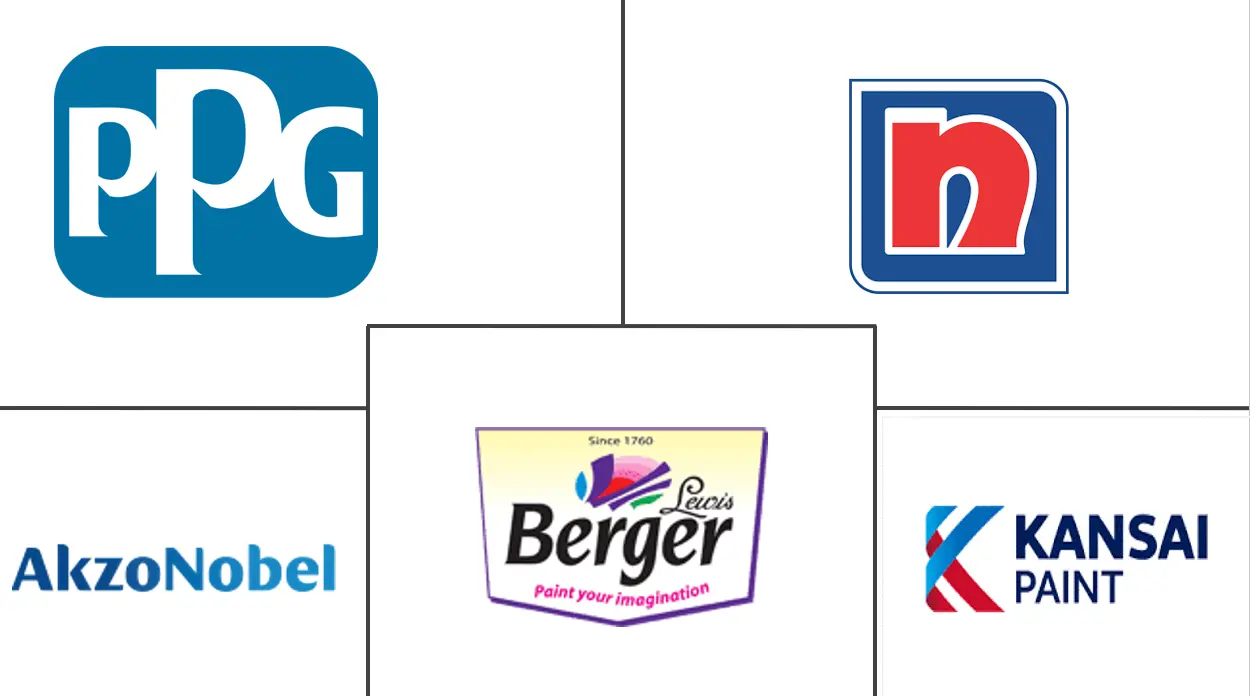Market Size of India Automotive OEM Coatings Industry

| Study Period | 2019 - 2029 |
| Base Year For Estimation | 2023 |
| Forecast Data Period | 2024 - 2029 |
| Historical Data Period | 2019 - 2022 |
| CAGR | < 10.00 % |
| Market Concentration | Medium |
Major Players
*Disclaimer: Major Players sorted in no particular order |
India Automotive OEM Coatings Market Analysis
The India Automotive OEM Coatings market is expected to reach around 670 million by the end of this year. It is projected to register a CAGR of over 9.7% during the forecast period. COVID-19 negatively impacted the market in 2020. However, the market has now been estimated to have reached pre-pandemic levels and is forecasted to grow steadily.
- The Increasing Demand for Passenger Cars is anticipated to be one of the major factors driving the growth of the Automotive OEM coatings market.
- On the flip side, shortages of semiconductors and other components are likely to negatively affect the demand for Auto OEM coatings consumption in the country.
- The Market expansion is anticipated to be supported by Increasing Demand for Electronic Vehicles.
- In the End-User segment, the Passenger Cars segment is expected to dominate the country's automotive OEM coatings market.
India Automotive OEM Coatings Industry Segmentation
Automotive OEM coatings are used to manufacture automotive vehicles' body parts. The market is segmented by Resin Type, Technology, and End-User Industry. By Resin, the market is segmented into acrylic, alkyd, polyurethane, epoxy, polyester, and other resins. Technology segments the market into water-borne, solvent-borne, and other coating technologies. End-User Industry segments the market into Passenger Cars, Commercial Vehicles, and ACE. For each segment, the market sizing and forecasts have been done based on revenue (USD million)
| Resin Type | |
| Epoxy | |
| Acrylic | |
| Alkyd | |
| Polyurethane | |
| Polyester | |
| Other Resin Type |
| Technology | |
| Water-borne | |
| Solvent-borne | |
| Others |
| End-user Industry | |
| Passenger Cars | |
| Commercial Vehicles | |
| ACE |
India Automotive OEM Coatings Market Size Summary
The India Automotive OEM Coatings market is poised for significant growth, driven by the increasing demand for passenger cars and the rising interest in electric vehicles. As one of the largest manufacturing sectors in India, the automotive industry plays a crucial role in the nation's economy, contributing substantially to its GDP. The market, which experienced a downturn due to the COVID-19 pandemic, has rebounded to pre-pandemic levels and is expected to continue its upward trajectory. The demand for automotive OEM coatings is primarily fueled by the shift towards more luxurious and safe transportation options. However, challenges such as semiconductor shortages could impact the market's growth. The passenger car segment is anticipated to dominate the market, supported by increased investments and advancements in the automotive sector.
The market landscape is characterized by a shift from solvent-borne to waterborne automotive OEM coatings, driven by stringent environmental regulations and the need for sustainable solutions. Waterborne coatings are gaining traction due to their favorable physical and chemical properties, such as high chemical resistance and solvent-free formulations. This transition is expected to enhance the market's growth prospects over the forecast period. The market is consolidated, with key players like Akzo Nobel N.V., PPG Asian Paints, and Berger Paints India Limited holding significant shares. Recent developments, such as BASF's expansion of its Automotive Coatings Application Center in Mangalore, highlight the ongoing efforts to innovate and improve customer service in the industry.
India Automotive OEM Coatings Market Size - Table of Contents
-
1. MARKET DYNAMICS
-
1.1 Market Drivers
-
1.1.1 Passenger Cars to Dominate the Market
-
1.1.2 Other Drivers
-
-
1.2 Market Restraints
-
1.2.1 Ongoing Shortage of Semiconductors
-
1.2.2 Other Restraints
-
-
1.3 Industry Value Chain Analysis
-
1.4 Porters Five Force Analysis
-
1.4.1 Threat of New Entrants
-
1.4.2 Bargaining Power of Buyers/Consumers
-
1.4.3 Bargaining Power of Suppliers
-
1.4.4 Threat of Substitute Products
-
1.4.5 Degree of Competition
-
-
-
2. MARKET SEGMENTATION (Market Size in Value)
-
2.1 Resin Type
-
2.1.1 Epoxy
-
2.1.2 Acrylic
-
2.1.3 Alkyd
-
2.1.4 Polyurethane
-
2.1.5 Polyester
-
2.1.6 Other Resin Type
-
-
2.2 Technology
-
2.2.1 Water-borne
-
2.2.2 Solvent-borne
-
2.2.3 Others
-
-
2.3 End-user Industry
-
2.3.1 Passenger Cars
-
2.3.2 Commercial Vehicles
-
2.3.3 ACE
-
-
India Automotive OEM Coatings Market Size FAQs
What is the current India Automotive OEM Coatings Market size?
The India Automotive OEM Coatings Market is projected to register a CAGR of less than 10% during the forecast period (2024-2029)
Who are the key players in India Automotive OEM Coatings Market?
Nippon Paint Holdings Co., Ltd, Kansai Paint CO. Ltd, Akzo Nobel N.V. , PPG Asian Paints and Berger Paints India Limited are the major companies operating in the India Automotive OEM Coatings Market.

